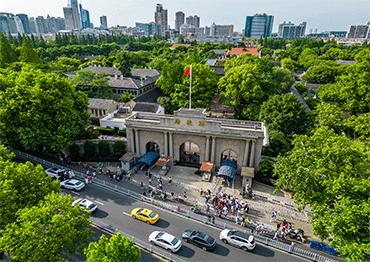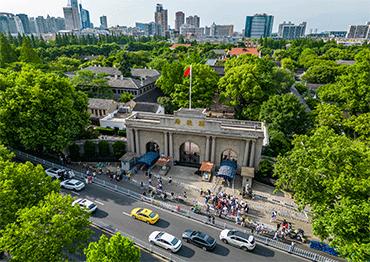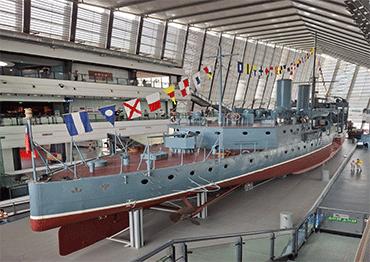
An aerial view of Nanjing Presidential Palace, Nanjing, Jiangsu Province, May 27, 2023 (Photo by VCG)
Dr Sun Yat-sen (1866-1925) is a monumental figure in Chinese history. He is held in high esteem by Chinese people across the Chinese mainland and many other regions and countries, as well as among Chinese diasporas. He is regarded as a revolutionary, a visionary and a nation-builder. This might explain why so many cities in China promote tourist attractions connected to Sun’s life and work. The story of Sun’s life is not only historically important, it is also fascinating, especially for those who are interested in the Chinese revolution of 1911 and the foundation of the Republic of China. Many people may not know that Sun’s life involved extensive periods abroad and he maintained close relationships with political and social reformists from across the world. Many of the ideas that shaped his vision for a new China were developed while he was in Honolulu, Singapore, London and Japan. However, his story commenced in a far humbler setting, in Cuiheng Village, Zhongshan in Guangdong Province. Millions of Chinese people visit Sun-related sites every year, and in chronological order, this is the first stop on the tour of the leader’s life.
There is a collection of museums in Cuiheng, which combine to offer a comprehensive memorial to Sun. Those include the Former Residence of Dr Sun Yat-Sen, the Sun Yat-Sen Memorial Hall, the Cuiheng Folk House Exhibition, and the Cuiheng Farming Exhibition. Visitors who travel north from Cuiheng can also visit Mount Litoujian where the tombs of the Sun family are located. Exploring Sun’s birthplace helps reveal the all-important sights, sounds and smells that would have shaped his early years and establish his world view. Cuiheng is easily accessible from either Guangzhou or Zhuhai, by taking a train to Nanlang Station, which lies about 10 minutes north by car.
Visitors to Cuiheng often base themselves in Guangzhou, capital of Guangdong Province. Due to Guangzhou’s proximity to his birthplace, it is perhaps unsurprising that the city also houses numerous buildings and institutions connected to Sun, including the Sun Yat-sen Memorial Hall. The hall is octagonal in shape, currently houses artistic performances and can be visited by tourists for a nominal fee. The hall was built because of fundraising by local and overseas Chinese people in Sun’s memory. However, the most interesting historical relevance lies not in the present building, but what came before – Guangzhou’s former Presidential Palace. The summer of 1922 witnessed a period of political turmoil, and the Presidential Palace was badly damaged in an attack by those opposed to Sun. Although he had already fled the building, his wife only narrowly escaped, to be later reunited with her husband on a large gunboat, called the Yongfeng.
The Yongfeng, renamed the Zhongshan in 1925 in honor of Sun – Sun Zhongshan is Sun’s name in standardized Chinese, while Sun Yat-sen is Cantonese – is now housed in an enormous museum building in the suburbs of Wuhan, in Central China’s Hubei Province. This museum is not only a fascinating tribute, it is one of the most unique museums in all of China. The Zhongshan had a long life, having been built in 1913 in Japan, but then sunk by the Japanese during World War II in 1938. For over half a century the ship lay under the waves, before being recovered in 1997 and restored for public view. Today the ship is elevated, allowing people to walk 360 degrees around it on platforms at multiple heights to understand what life aboard must have been like. Fittingly, those restoring the ship have retained the dramatic hole in the side of the boat which caused it to sink. This gaping wound contrasts sharply with the ship’s otherwise magnificence, reminding every visitor of their own mortality and limitations.
The location of the Zhongshan gunboat in Wuhan is no coincidence, for it is arguably in Wuhan that the 1911 Revolution (the Xinhai Revolution) started. The location of the Wuchang Uprising is now honored with a series of museums and memorials. To the north of Pengliuyang Road, visitors will find the Memorial of the Wuchang Uprising, housed in a building from 1910 that was briefly home to a regional government established in response to political pressures for reform during the latter months of the Qing Dynasty (1644-1911). Needless to say, the Qing reforms were deemed too little too late, and the building soon became home to the temporary military government, which took charge during the turmoil of the revolution. To this day the building still flies the nine-pointed-star flag of the revolutionary military leadership, and guests can visit the well-preserved parliamentary chamber in which the most important government meetings took place.
To the south of Pengliuyang Road, across a mighty open square, is the 1911 Revolution Museum. This post-modern building was commissioned to celebrate 100 years since the uprising. This cutting-edge museum is designed to bring excitement, intrigue and fascination to those learning about this important period of Chinese history. A series of exhibitions, over multiple floors, include interactive elements, videos, important objects and realistic displays of important moments using life-size waxworks and dramatic sets. Some of the most interesting displays include a meeting between the boy Emperor Puyi and his advisors, and Sun discussing detailed plans with a group of revolutionaries in Japan. However, the most dramatic displays are those that replicate battle scenes.
Following the success of the Xinhai Revolution, Sun Yat-sen traveled to Nanjing, capital of east China’s Jiangsu Province, where he was sworn in as provisional president of the Republic of China in the former Qing Governor-General’s palace. This palace became the Presidential Palace, and although it was not officially used by the Republic of China until 1927 due to civil turmoil, Sun kept offices in the building. The Presidential Palace in Nanjing is designed so visitors can experience a diverse range of eras as they explore. From ornate buildings that clearly reflect the era of monarchy to efficient modernist office blocks built to serve practical needs, visitors see different slices of Chinese history frozen in time.
Sadly Sun died aged just 58 in 1925. He clearly loved Nanjing and dreamed of it becoming the capital of his nascent nation. As a result, he requested to be buried in the city. The location chosen for his mausoleum was the Purple Mountain just outside the ancient city walls. Visitors can now visit a large scenic area dedicated to a magnificent memorial hall and tombstone, as well as archways and other monuments.
As a well-traveled man, there are numerous locations connected to the life of Sun Yat-sen that are popular with tourists in cities including Shanghai, Beijing and Hong Kong. However, it seems fitting that any journey to explore the life of this visionary leader should start in the village of Cuiheng, and end on a serene hill outside Nanjing.

 Old Version
Old Version

